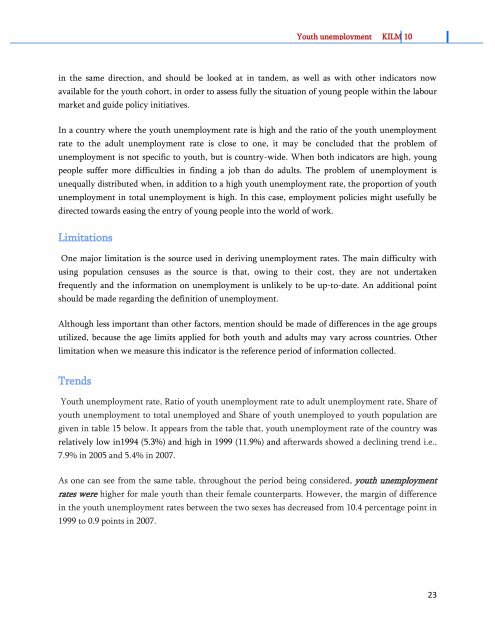Ethiopia KILM
Ethiopia KILM
Ethiopia KILM
- No tags were found...
Create successful ePaper yourself
Turn your PDF publications into a flip-book with our unique Google optimized e-Paper software.
Youth unemployment <strong>KILM</strong> 10<br />
in the same direction, and should be looked at in tandem, as well as with other indicators now<br />
available for the youth cohort, in order to assess fully the situation of young people within the labour<br />
market and guide policy initiatives.<br />
In a country where the youth unemployment rate is high and the ratio of the youth unemployment<br />
rate to the adult unemployment rate is close to one, it may be concluded that the problem of<br />
unemployment is not specific to youth, but is country-wide. When both indicators are high, young<br />
people suffer more difficulties in finding a job than do adults. The problem of unemployment is<br />
unequally distributed when, in addition to a high youth unemployment rate, the proportion of youth<br />
unemployment in total unemployment is high. In this case, employment policies might usefully be<br />
directed towards easing the entry of young people into the world of work.<br />
Limitations<br />
One major limitation is the source used in deriving unemployment rates. The main difficulty with<br />
using population censuses as the source is that, owing to their cost, they are not undertaken<br />
frequently and the information on unemployment is unlikely to be up-to-date. An additional point<br />
should be made regarding the definition of unemployment.<br />
Although less important than other factors, mention should be made of differences in the age groups<br />
utilized, because the age limits applied for both youth and adults may vary across countries. Other<br />
limitation when we measure this indicator is the reference period of information collected.<br />
Trends<br />
Youth unemployment rate, Ratio of youth unemployment rate to adult unemployment rate, Share of<br />
youth unemployment to total unemployed and Share of youth unemployed to youth population are<br />
given in table 15 below. It appears from the table that, youth unemployment rate of the country was<br />
relatively low in1994 (5.3%) and high in 1999 (11.9%) and afterwards showed a declining trend i.e.,<br />
7.9% in 2005 and 5.4% in 2007.<br />
As one can see from the same table, throughout the period being considered, youth unemployment<br />
rates were higher for male youth than their female counterparts. However, the margin of difference<br />
in the youth unemployment rates between the two sexes has decreased from 10.4 percentage point in<br />
1999 to 0.9 points in 2007.<br />
23


